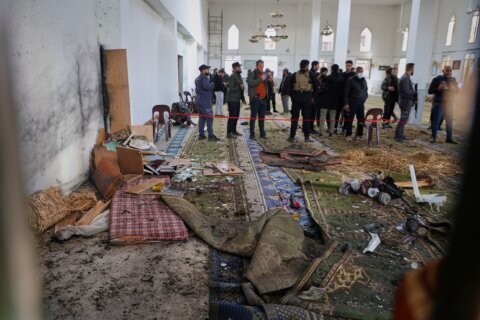JEREMIE, Haiti (AP) _ As the pale blue coffin came into view, the grieving women flung themselves to the floor near a morgue that overlooked the hurricane-ravaged city of Jeremie, the apparent epicenter of Haiti’s growing humanitarian crisis.
They beat their fists and screamed, their distress growing more intense as attendants opened the door of the morgue on Saturday to bring out the body of Roberto Laguerre, who was killed next to his 3-year-old daughter when Hurricane Matthew roared over this city in southwest Haiti as a Category 4 storm earlier this week.
“Why did you leave us? Take me with you!” shouted relative Rita Honore.
Roberto and his little girl, Roseberlande, are among the 470 people who died in just one district in southwest Haiti devastated by Matthew as the country braces for a rise in cholera cases and grapples with what could become the worst crisis since a catastrophic 2010 earthquake.
Jeremie is the main city of the department of Grand-Anse, located on the northern tip of Haiti’s southwest peninsula, where authorities believe the death toll and damage is highest. Fridnel Kedler, coordinator for the Civil Protection Agency in Grand-Anse, told The Associated Press that officials still haven’t been able to reach two communities within that department three days after the hurricane hit.
“The death toll is sure to go up,” he said.
Reports of deaths in those areas were slow to reach the Civil Protection Agency’s headquarters in Port-au-Prince, where authorities said Saturday that the official death toll for the whole country so far was 336 people. It wasn’t immediately clear whether some of the 470 deaths in Grand-Anse were included in that count. The agency also said that more than 60,000 people remained in shelters.
Death tolls are frequently difficult to tabulate in the immediate aftermath of a natural disaster in any country, though it is particularly difficult in remote and mountainous southwest Haiti.
Government officials estimate that at least 350,000 people need assistance, and concern was growing over an increase in cholera cases following widespread flooding unleashed by Matthew. An ongoing cholera outbreak has already killed roughly 10,000 people and sickened more than 800,000 since 2010, when the infectious disease was introduced into the country’s biggest river from a U.N. base where Nepalese peacekeepers were deployed.
Maria Sofia Sanon, a health worker overseeing the open-air cholera treatment center in a corner of Jeremie’s main hospital, said they were ill-equipped to deal with patients. The area was strewn with broken tree branches, and a group of young mothers sat outside holding up the arms of their glassy-eyed children being rehydrated via IVs.
“They’re not supposed to be in the sun, but we have no more beds,” Sanon said.
Nearby, officials with the Red Cross were unloading blankets, soaps, bleach and other items as aid began to reach remote corners of Haiti’s southwest peninsula.
“It’s beginning to pick up now,” said Stephane Rolland, coordinator for the International Federation of the Red Cross for Cuba, Haiti and the Dominican Republic.
Cuban medical teams were dispatched to coastal villages, and officials began distributing food in storm shelters and in the main plaza of Jeremie, where thousands of homes were damaged or destroyed and many people were running low on food.
Jocelyne Saint Preux was part of the crowd that lined up in an orderly fashion to get food. The mother of three children whose home was destroyed said officials were handing out wheat, beans, oil and salt.
“Yes, they brought food, but it’s not sufficient,” she said. “There’s no water. There’s no charcoal.”
As aid trickled into Jeremie, Jislene Jean-Baptiste surveyed what remained of the one-room house that the grandmother shares with her three daughters and their children. There wasn’t much left. Storm surge flowed across the road and drenched her belongings in waist-deep salt water, washing away the stores of rice and sugar she regularly sold at the market to support her family. Then the wind tore off her roof.
“That storm was the most terrifying thing that ever happened here,” she said.
Copyright © 2025 The Associated Press. All rights reserved. This material may not be published, broadcast, written or redistributed.






